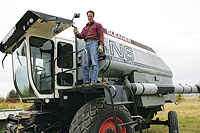How's this for irony: farmers gobbling up potential real estate development instead of the reverse.
When major beer brewers discovered the rare, choice quality of malt barley growing in Blaine County, developers' plans for turning the Bellevue Triangle into a sea of five-acre ranch estates were nipped in the bud (to make a pun) and thousands of acres of grain were allowed to flourish.
"Barley saved the Triangle," insists longtime Picabo agricultural entrepreneur and civic figure Nick Purdy.
The whole area south of Bellevue, he said, was zoned for five-acre ranchettes, until corporate brewers Coors and Budweiser began signing up for deliveries of malt barley, thereby creating a major new agricultural industry for the Blaine County area and heading off a real estate boom in the Bellevue Triangle.
According to University of Idaho extension agent Ron Thaemert, who works the Blaine County agricultural circuit, some 14,200 acres are cultivated in seasonal malt barley. Thaemert estimates the economic impact at about $4.5 million annually.
Purdy is one of a dozen or more malt barley farmers in the area. He first signed a contract 10 years ago with Budweiser to deliver barley from an 800-acre tract among his large farming and ranching operation.
Malt barley farming has been a viable business for farmers in the area for at least 25 years, Purdy said. However, the market price, he said, is less than it was two decades ago, a phenomenon he can't explain.
The market for malt barley is $6.75 per hundredweight, $5 per hundredweight for feed barley for cattle.
What makes Blaine County malt barley so desirable to brewers?
Thaemert credited the area's higher elevation and climate of cooler nights for what he described as "unique" barley, whose kernels provide tastier brew.
The brewing process first adds barley kernels to water in a steep tank, which triggers more growth of the kernels, spurring a germination process that changes the original kernel into finer ingredient for brewing.
Barley farms in the area, Thaemert said, range in size from 100 acres to 1,000 acres.
Another of the farmers is Rocky Sherbine, who sells barley to Coors from 250 acres and to Budweiser from another tract of 500 acres.
Along with Purdy, Sherbine also complained that market prices today are less than nearly three decades ago, when, he recalls, it was $7 per hundredweight.
Larry Schoen, another farmer and member of the county's Planning and Zoning Commission, says he sells just under a million pounds annually to Coors.
Malt barley's growing season lasts about 120 days, Sherbine said. Planting begins as soon as snow disappears.
According to the Idaho Department of Agriculture, Idaho farmers produced just over 52 million bushels of barley in 2005, worth an estimated $151 million. Blaine County, the department notes in its 2006 annual report released this week, produced 1,328,000 bushels in 2005 from 12,100 acres planted. Those figures were down from 1,530,000 bushels produced from 14,300 acres planted in 2004.
Spokesmen for Coors and Budweiser could not be immediately reached for comment about the barley operations in Blaine County.


 Bellevue Triangle barley farmer Larry Schoen takes a break after completing the season?s harvest. He says he sells just under a million pounds of barely every year to Coors, the Colorado-based brewer. Photo by Chris Pilaro
Bellevue Triangle barley farmer Larry Schoen takes a break after completing the season?s harvest. He says he sells just under a million pounds of barely every year to Coors, the Colorado-based brewer. Photo by Chris Pilaro



































